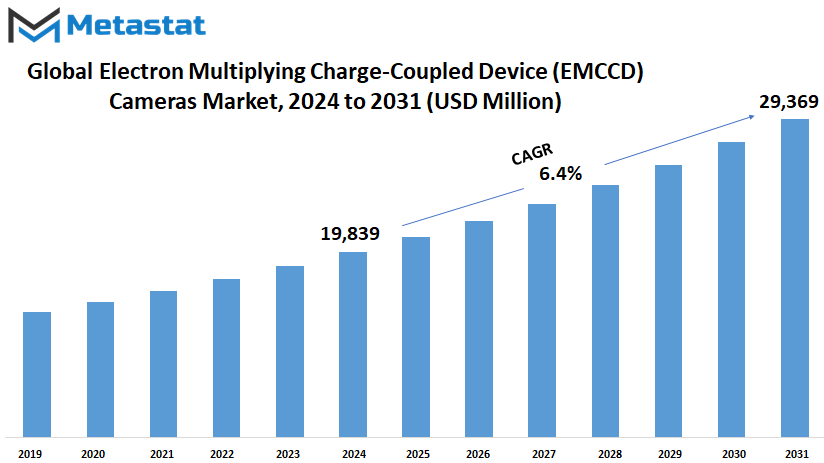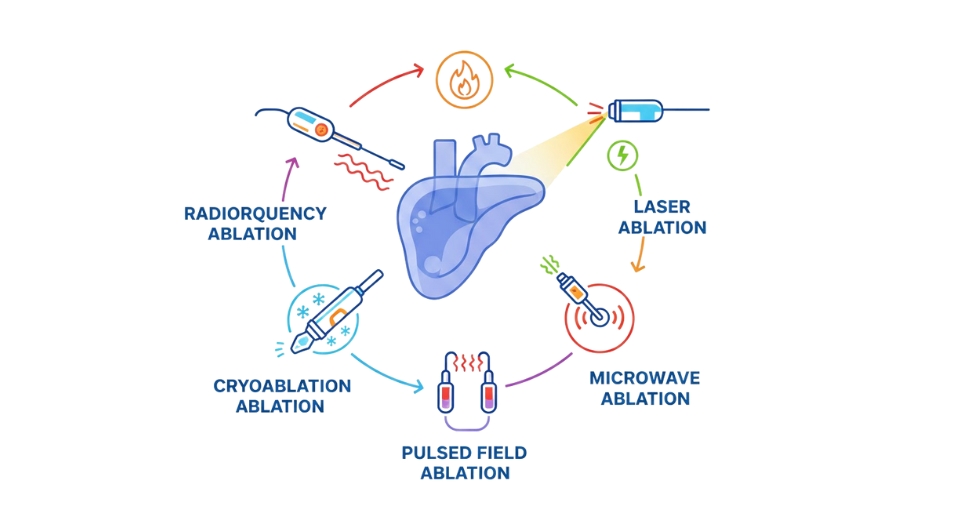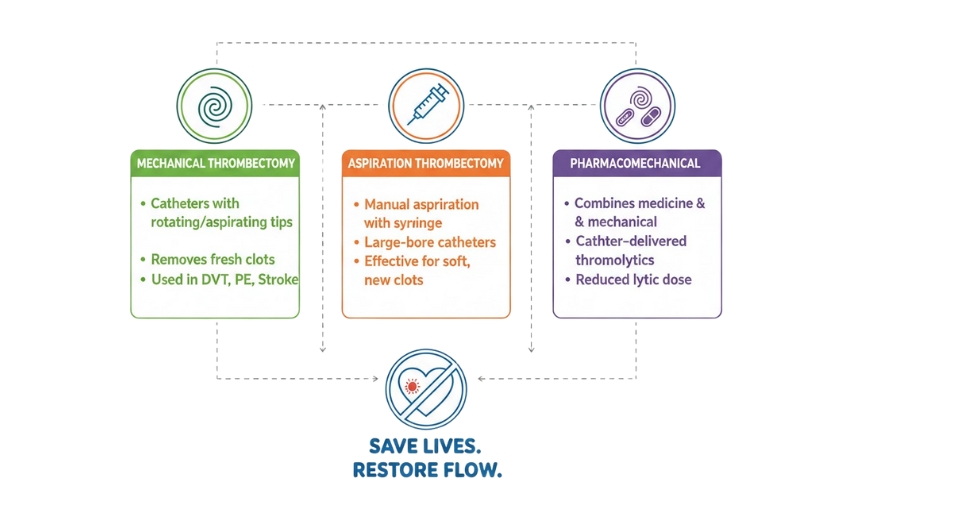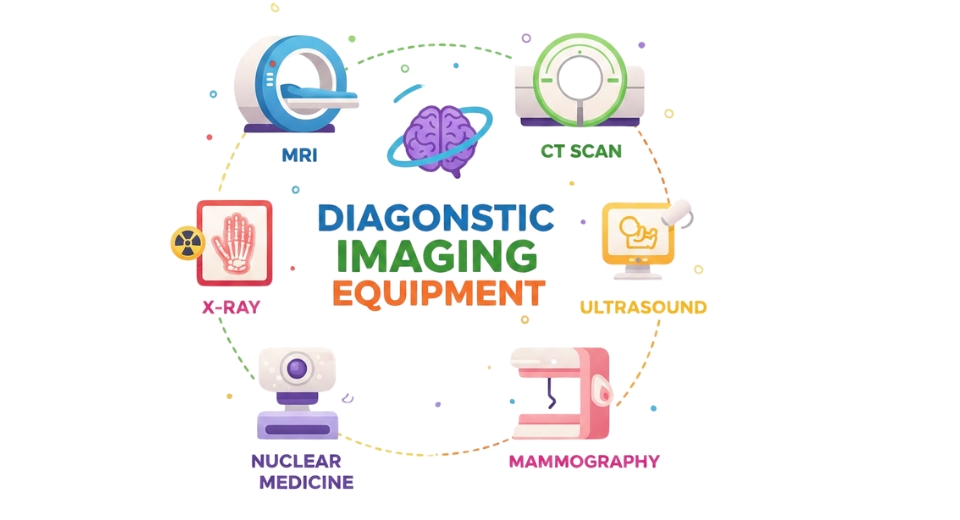MARKET OVERVIEW
The global electron multiplying charge-coupled device cameras market is bound to make a difference in various industries with advanced imaging technology. The performance of EMCCD cameras in low-light, high-sensitivity conditions of imaging is very impressive and sure to become a cornerstone in sectors related to high-precision imaging. On the basis of electron multiplication, these cameras can detect even the faintest signals of light, which makes them quite useful in astronomy, medical diagnosis, and surveillance.
In the near future, EMCCD cameras are likely to be at the forefront in aiding astronomers in making more precise observations. With these cameras, scientists will get clearer pictures of space bodies that are some distance from earth, thus managing to solve more mysteries of the universe. The fact that they can function effectively in low light will make them a constant companion in space research and any other venture.
Medical diagnostics will reach a very advanced level with the implementation of EMCCD technology. High-resolution images captured by such cameras will be essential for detailed analysis, and many diseases can be detected at an early stage for proper treatment. The application of EMCCD cameras, especially in fluorescence microscopy, is going to be immense help. It will lend sensitivity and clarity unmatched by any other available techniques.
Security and surveillance are, in turn, going to benefit from these exceptional competencies of EMCCD cameras. Superior low-light imaging will yield better measures of monitoring and security. Critical infrastructure protection, border security, and public safety are going to need such cameras owing to their ability to produce clear and vivid visuals independent of light conditions.
Besides, the Global Electron Multiplying Charge-Coupled Device Cameras market will make inroads into the application fields of industry. These cameras will refine quality control processes associated with manufacturing, ensuring higher precision and effectiveness. Their characteristic of clicking minute details will help in inspecting and verifying products, reducing defects and increasing product quality.
The entertainment industry is yet another area to adopt EMCCD technology. Both filmmakers and content developers will make use of these cameras in producing highly intra-image textured scenes where lighting conditions are very poor. This technology will open wide avenues for creativity, allowing the production of highly wonderful content that was previously unattainable.
With increasing efforts by manufacturers toward better performance and price reduction to attract a wider user base, the EMCCD camera market is likely to remain at the forefront of innovative steps. These may include speed enhancements in image capture, reductions in power consumption, and integration with other advanced technologies such as artificial intelligence and machine learning.
The use of EMCCD cameras in teaching and research applications in the education sector is yet another area that will be fully implemented. From universities to other research institutions, these cameras will be used to train students in sophisticated image-acquisition techniques that will be needed to build the next generation of scientists and engineers.
In this budding course of the Global Electron Multiplying Charge-Coupled Device Cameras market, numerous opportunities will spur collaboration and further innovation. Enterprises from industries will team up to bring to bear the unique capabilities of the EMCCD technology in fanning the flames of progress that shall bring gain to all.
The Electron Multiplying Charge-Coupled Device Cameras market globally is going to realize enormous growth and development. It will have an impact that will cut across several sectors, from scientific research all the way to industrial applications, medical diagnoses, and beyond. This new development of the EMCCD technology is bringing a new frontier of precision and clarity in the realm of imaging and definitely will prove to be an indispensible tool for the future.
Global Electron Multiplying Charge-Coupled Device (EMCCD) Cameras market is estimated to reach $29,369 Million by 2031; growing at a CAGR of 6.4% from 2024 to 2031.

GROWTH FACTORS
The Electron Multiplying Charge-Coupled Device (EMCCD) Cameras market is developing at a high CAGR in the future. The drivers identified for this growth are rising demands for highly sensitive imaging solutions from scientific research, astronomy, and biomedical applications. These fields need precise and detailed imaging capabilities, and with an ability to enhance sensitivity and improve the signal-to-noise ratio, EMCCD cameras stand in a special place to cover these needs. This enables capturing of details even in the most unfavorable environments. Another driver for this market is developments in imaging technologies.
With increasing advances in technology, the demand for cameras capable of delivering enhanced sensitivity is also on the rise. Excellent imaging performance is the basis for several types of scientific and medical applications, so EMCCD cameras are possessed with this excellence in performance. New developments in EMCCD cameras can be expected to drive demand further upwards, particularly in those areas where researchers and professionals are reaching out for greater capabilities in order to keep up with their work. However, the price difference between them, as compared to regular CCD or CMOS cameras, remains significantly large for any potential buyer. These cameras can be very expensive for many potential users to afford and invest in such advanced technology.
Also, special expertise is required in the manufacturing process of EMCCD cameras and their maintenance, thus setting further limits on their availability. This lack of easy access to knowledge and resources may slow the growth of the market, since only a limited number of professionals can use and service such sophisticated devices. Despite all odds, there are some very promising opportunities for the market. Cost-effective, user-friendly EMCCD camera systems would increase their accessibility manifold.
Manufacturers can create more pocket-friendly models without sacrificing too much in terms of performance; this will ensure that more industries eventually use this technology. This would enhance the growth of the market and increase innovation in new applications for EMCCD cameras across various fields. Provided technology enables it and the economics allows it, there will come a boom in the EMCCD camera market.
A continuous push toward an improvement in imaging technology and in lowering costs and increasing user-friendliness will probably move the market forward. The need for high-sensitivity imaging solutions will become stringent once industries such as these begin to realize their value; hence, the demand for EMCCD cameras will rise accordingly and thereby open up further growth and development in this sector in the future.
Despite being surrounded by numerous bottlenecks, huge potential exists for the growth of the global EMCCD camera market. In this regard, technical progress and the urge to make systems less costly and more widely available will be characteristic of the future and sustain the development of the market in many fields of science and industry.
MARKET SEGMENTATION
By Type
It is expected that the Electron Multiplying Charge-Coupled Device Cameras market will grow significantly in the near future. The cameras are turning out to be of imperative use with increasing technological changes in the respective fields. EMCCD cameras have been highly valued because they offer brilliant image capture in conditions involving very low light, hence making them critically important in scientific research, medical imaging, and security surveillance.
The ability of these cameras to amplify the signal prior to reading out makes even faint light sources detectable, providing an unparalleled clarity of images. As industries go on harnessing the benefits derived from EMCCD cameras, the global market would grow.
By type, it gets segmented into black and white cameras and color cameras. Black and white EMCCD cameras best fit applications where fine details and contrast should be maximally maintained. These include, particularly, astronomy and some scientific applications. Color differentiation is necessary for particular applications, usually biological research or some medical diagnostics, therefore color EMCCD cameras are required.
Looking ahead, demand for EMCCD cameras will surge as these gain enhanced performance capabilities. Compact, efficient, and more affordable designs are the focus of research in this field, hence making them more widely available to many users, from small research labs to large industrial applications. Further, the growing security concerns worldwide are paving the way for EMCCD cameras through the rising demand for reliable surveillance equipment.
The cameras' feature of functioning from dusk to dawn and in darkness enhances their utility in security and defense applications. Machine learning and artificial intelligence are also lending a hand to EMCCD cameras by running image analysis and interpretation procedures.
EMCCD cameras innovated diagnostic imaging in the medical field, having high sensitivity and resolution that allow for more accurate and earlier detection of medical conditions, important for effective treatment. Only with the integration of the EMCCD cameras into diagnostic equipment is it likely to increase in the future when healthcare systems around the world strive to improve patient outcomes.

By Application
Owing to the wide range of applications that EMCCD cameras have, much growth is expected in the future. Characterized majorly by high sensitivity and low noise performance, these cameras are becoming very important in different fields. One key area where impacts of EMCCD cameras are very notable is in laboratories.
These cameras can provide a base for researchers to capture low-light images with high precision and enable ground-breaking discoveries in such fields as biology and astronomy. Since their ability to detect faint signals with exceptionally clear resolution, EMCCD cameras are of great value in scientific research. The EMCCD camera turns out to be no less of a revolution in industrial applications.
It assists considerably the industries in which imaging to a higher level of precision under very poor lighting conditions needs to be effected, such as semiconductor manufacturing and quality control. Correct imaging is thus provided, which will assist in detecting flaws and ensuring the quality of the products for both high standard and efficiency in the production processes.
Another class of applications for EMCCD cameras includes yet another set of ingenious uses that bring out the versatility of these cameras. For instance, in surveillance, EMCCD cameras perform better under low light and can generally enhance the security of areas considered critical. With their high sensitivity and resolution, they are ideally suited for nighttime surveillance and all other demanding applications where conventional cameras easily fail.
REGIONAL ANALYSIS
In the long term, the global electron multiplying charge-coupled device cameras market will increase manifold. The EMCCD cameras are highly sensitive and click pictures even when lighting conditions are very poor; hence, their demand is increasing in many sectors. Their demand will rise with the advancement in technology as a result of their applicability in astronomy, medical imaging, and scientific research.
Geographically, it can be divided into the following regions: North America, Europe, Asia-Pacific, South America, and Middle East & Africa. Each of these regions is offering an opportunity and difficulties related to the growth in the EMCCD cameras market.
North America holds a leading market share of EMCCD cameras, which caters to the region comprising the U.S., Canada, and Mexico. Leaders in technology and leading research institutions arebased in the region, creating demand for advanced imaging devices. Just the United States accounted for the largest share due to its heavy research and development activities in science and technology.
The leaders in the market on the European continent include the UK, Germany, France, and Italy. Many research institutions and industries that use EMCCD cameras are located in these countries. The commitment to scientific development and technological innovations keeps the boost going on for the market.
The Asia-Pacific region is fragmented into countries like India, China, Japan, and South Korea, and it is developing at a rapid rate. Expanding healthcare and increased funding for scientific research are fueling the growth for EMCCD cameras. Both China and Japan are important markets in their own right, with technological sophistication and major research grants.
South America is also an area where, including Brazil and Argentina, the market growth looks quite promising. The emphasis on scientific researches and technological developments in this region has increased slowly, and this fact would drive the demand for EMCCD cameras.
The Middle East & Africa region also shows growth prospects, covering GCC countries, Egypt, and South Africa. Most of these regions are developing their healthcare and research infrastructure; hence, demand for advanced imaging technologies like EMCCD cameras will rise accordingly.
Therefore, the global Electron Multiplying Charge-Coupled Device Cameras market has huge potential to expand. When regions are investment in technological development and scientific research, it would increase the demand for high-performance imaging devices. Innovations and improvements in EMCCD camera technology would likely be fueled by this growth, benefiting a wide array of industries and applications.
COMPETITIVE PLAYERS
The Electron Multiplying Charge-Coupled Device Cameras market globally is projected to witness notable growth in the following couple of years. Their capability of detecting very low light levels with high sensitivity makes them an instrument of great importance in various scientific and industrial applications. In the midst of continuous technological progress, the demand for EMCCD cameras is likely to grow due to the need for precise imaging in many fields such as astronomy, biomedical research, and security vigilance.
In that respect, the key players in the EMCCD cameras industry Andor Technology, Ball Aerospace, Cairn Research Ltd., First Light Imaging SAS, GEViCAM Inc., Hamamatsu Corporation, HORIBA UK Ltd., Keo Scientific Ltd., Nuvu Cameras, Photonis Netherlands BV, Princeton Instruments, QuantumDesign, Raptor Photonics Ltd., SciTech Pty. Ltd., SK-advanced, SnowHouse Solutions, and Teledyne Photometrics—are continuously upgrading in an effort to enhance camera performance and functionality.
These companies are focused on investing in research and development to be ahead in the competitive market and meet the changing needs of their customers. Again, looking into the future, new developments in complementary technologies are bound to benefit the market for EMCCD cameras. For example, improvements in data processing and storage solutions will continue to make it easier to process those high-resolution images output by the EMCCD cameras. In the same light, integration with artificial intelligence and machine learning algorithms will enhance image analysis capability for more accurate and faster interpretations of captured data.
Adoping the same cameras in emerging and new fields further drives market growth. The details that would be captured by EMCCD cameras will be very useful in rendering high-resolution images of distant celestial objects to assist the invention of new planets and galaxies. In medical diagnostics, clearer and more detailed images improve diagnosis, and hence the prognosis of diseases will improve with early detection in patients. It will also improve security and surveillance related to high sensitivity, since it will increase monitoring abilities over critical infrastructure and open public places with the help of EMCCD cameras.
It is highly likely that this competitive landscape of the EMCCD cameras market will further drive cooperation between the key players and other technology companies. There will be partnerships and alliances to develop integrated solutions that can be driven with the aid of EMCCD cameras' unique strength, coupled with other advanced technologies. The Electron Multiplying Charge-Coupled Device Cameras market globally shows great promise due to continuous technological advancement and broadening applications. These are important factors, keeping the key players in this industry in a very good position to grow their trends and ensure the continued evolution and success of EMCCD camera technology. These cameras will leave their mark in fields as varied as scientific research and everyday security in the coming times. The impact will underline the importance of these cameras in our ever-increasingly technology-driven world.
Electron Multiplying Charge-Coupled Device (EMCCD) Cameras Market Key Segments:
By Type
- Black and White Camera
- Color Camera
By Application
- Laboratory
- Industrial
- Other
Key Global Electron Multiplying Charge-Coupled Device (EMCCD) Cameras Industry Players
- Andor Technology
- Ball Aerospace
- Cairn Research Ltd.
- First Light Imaging SAS
- GEViCAM Inc.
- Hamamatsu Corporation
- HORIBA UK Ltd.
- Keo Scientific Ltd.
- Nuvu Cameras
- Photonis Netherlands BV
- Princeton Instruments
- QuantumDesign
- Raptor Photonics Ltd.
- SciTech Pty. Ltd.
- SK-advanced
WHAT REPORT PROVIDES
- Full in-depth analysis of the parent Industry
- Important changes in market and its dynamics
- Segmentation details of the market
- Former, on-going, and projected market analysis in terms of volume and value
- Assessment of niche industry developments
- Market share analysis
- Key strategies of major players
- Emerging segments and regional growth potential








 US: +1 3023308252
US: +1 3023308252






